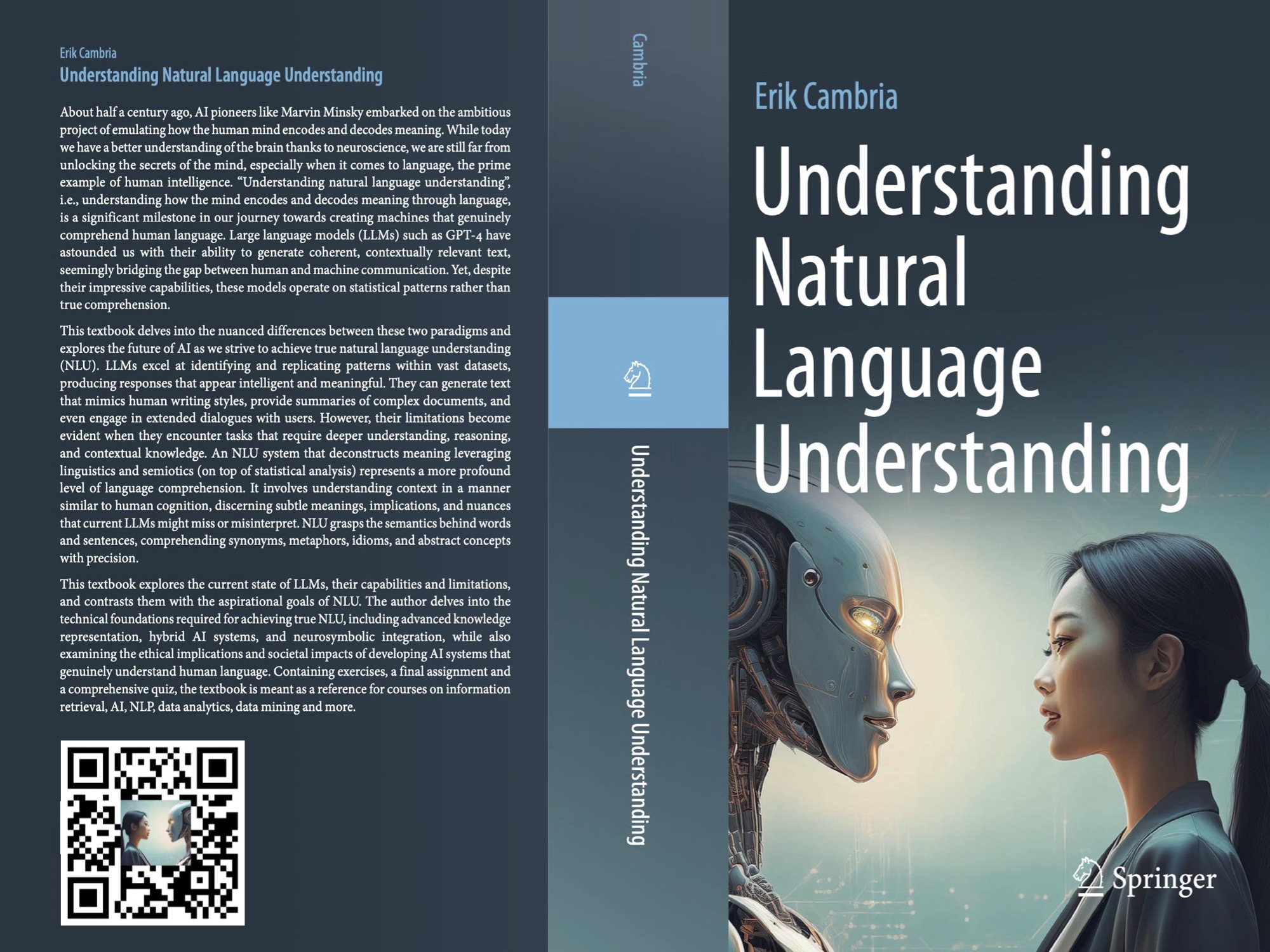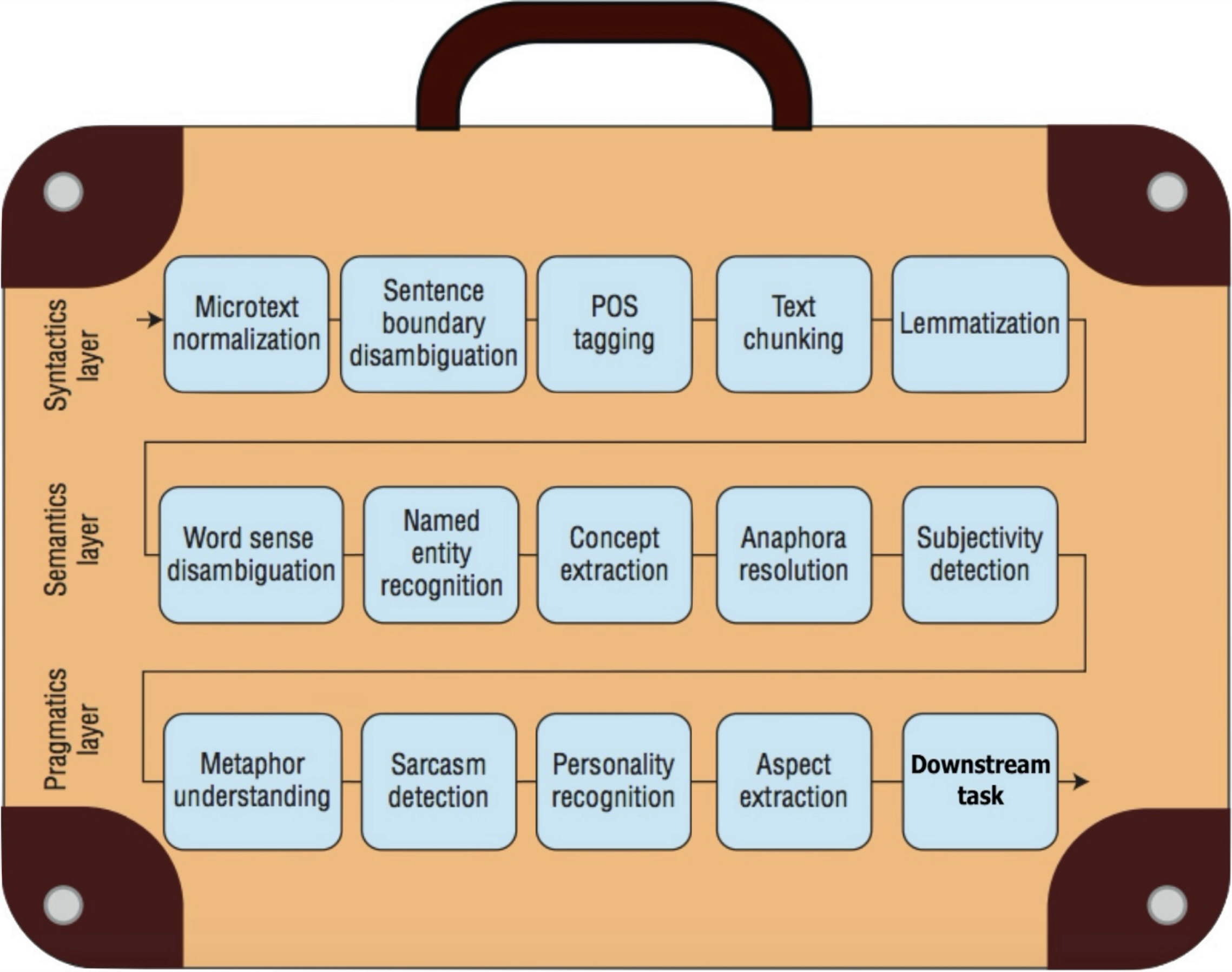Sentic Computing
Sentics refer to our individual perception and interpretation of the world, which are shaped by a combination of emotions, past experiences, personal preferences, personality traits, and cultural background. These factors influence how we react to and process information, making sentiment highly subjective and context-dependent. Sentic computing is a neurosymbolic AI approach that performs fine-grained analysis of text, audio, and video by taking into account these personal and contextual factors. Unlike traditional sentiment analysis methods that rely solely on lexicons or statistical models, sentic computing integrates both symbolic and subsymbolic AI techniques to better understand the nuanced ways in which emotions and cognition interact, allowing for more accurate sentiment interpretation across different users and contexts.
Sentic computing stands at the intersection of affective computing, cognitive science, and semiotics. It shares a strong connection with affective computing, which focuses on recognizing and responding to human emotions, and cognitive science, particularly in the integration of commonsense knowledge to enhance AI comprehension. Additionally, it aligns with semiotics by interpreting symbols, signs, and contextual cues to refine meaning extraction and sentiment understanding. By incorporating these disciplines, sentic computing enables AI to not only process explicit content but also grasp implicit emotional and cultural connotations, fostering more context-aware and human-like interactions.

Sentic computing, whose term derives from the Latin sentire (root of words such as sentiment and sentience) and sensus (as in commonsense), takes an approach to reasoning that is both top-down and bottom-up. Top-down for the fact that sentic computing leverages symbolic models (such as semantic networks and knowledge graphs) to encode meaning in an explainable way. Bottom-up because we use sub-symbolic paradigms (such as large language models and and transformers) to identify patterns and extract insights from data.

Coupling symbolic and sub-symbolic AI is key for stepping forward in the path from natural language processing (NLP) to natural language understanding (NLU). Relying solely on machine learning, in fact, is simply useful to make a 'good guess' based on past experience, because sub-symbolic methods only encode correlation and their decision-making process is merely probabilistic. NLU, instead, requires much more than that. To use Noam Chomsky's words, "you do not get discoveries in the sciences by taking huge amounts of data, throwing them into a computer and doing statistical analysis of them: that’s not the way you understand things, you have to have theoretical insights".

Over the last decade, sentic computing has positioned itself as a horizontal technology that serves as a back-end to several applications in many different areas, including: e-business (e.g., to help businesses understand their target audience’s preferences and tailor their offerings and marketing strategies accordingly), e-commerce (e.g., to identify popular items and trends, update product listings, adjust prices, and address customer concerns), e-tourism (e.g., to enable travel companies to gauge travelers' satisfaction and identify areas for improvement), e-mobility (e.g., to identify potential customers and address concerns related to electric vehicle adoption, such as range anxiety, charging infrastructure, and cost), e-governance (e.g., to develop targeted communication strategies, enhance public services, and address pressing issues), e-security (e.g., to help organizations monitor and detect potential security threats and vulnerabilities), e-learning (e.g., to create personalized learning experiences by understanding learners’ preferences, learning styles, and interests), and e-health (e.g., to monitor public opinion on various health issues, such as vaccination and mental health, and develop targeted communication campaigns and raising awareness).

Sentic computing takes a holistic approach to natural language understanding by handling the many sub-problems involved in extracting meaning and polarity from text. While most works approach it as a simple categorization problem, in fact, sentiment analysis is actually a suitcase research problem that requires tackling many NLP tasks. As Marvin Minsky would say, the expression 'sentiment analysis' itself is a big suitcase (like many others related to affective computing, e.g., emotion recognition or opinion mining) that all of us use to encapsulate our jumbled idea about how our minds convey emotions and opinions through natural language. Sentic computing addresses the composite nature of the problem via a three-layer structure that explicitly handles important NLP tasks such as named entity recognition, personality detection, metaphor understanding, and aspect extraction, which other NLP classifiers are instead forced to implicitly handle without proper training.

The core element of sentic computing is SenticNet, a large commonsense knowledge base built via an ensemble of symbolic and subsymbolic AI tools. In particular, SenticNet uses deep learning to generalize words and multiword expressions into primitives, which are later defined by means of logical reasoning in terms of superprimitives. For example, expressions like purchase_samsung_galaxy, shop_for_iphone, or buy_huawei_mate are all generalized as BUY(PHONE) and later deconstructed into smaller units thanks to definitions such as BUY(𝑥) = GET(𝑥) ∧ GIVE($), where GET(𝑥) is defined in terms of the superprimitive HAVE as the transition from not having 𝑥 to having 𝑥, i.e., ! HAVE(𝑥) → HAVE(𝑥). The superprimitive HAVE, finally, is defined by means of first order logic as HAVE(subj, obj) = ∃ obj @ subj.

This way, sentic computing is one step closer to natural language understanding and is superior to other purely statistical NLP frameworks that do not truly encode meaning. Moreover, the sentic computing framework is reproducible (because each reasoning step can be explicitly recorded and replicated through each iteration), interpretable (because the process that generalizes input words and multiword expressions into their corresponding primitives is fully transparent), trustworthy (because classification outputs, e.g., positive versus negative, come with a confidence score), and explainable (because classification outputs are explicitly linked to emotions and the input concepts that convey these).





